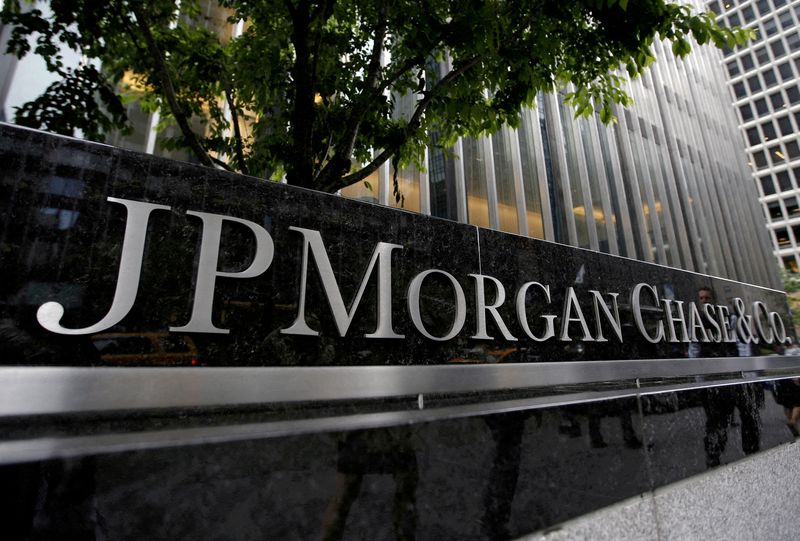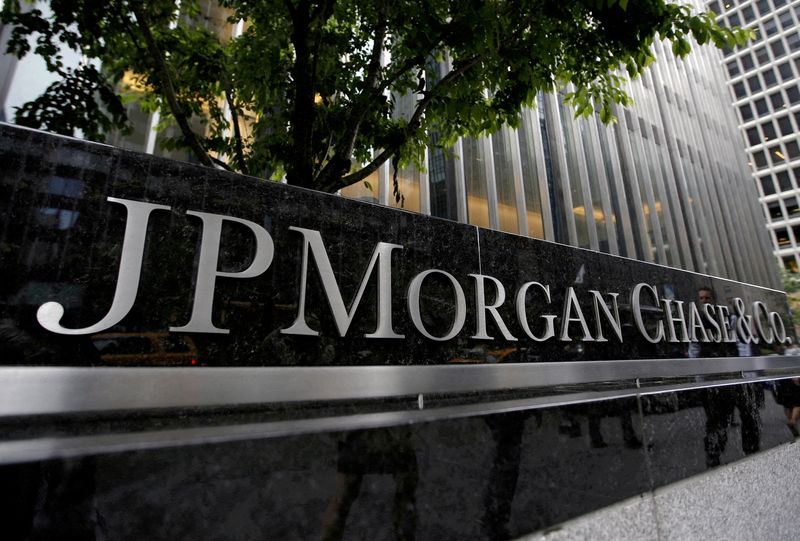Economy
Top U.S. banks raise dividends after sailing through Fed stress tests


© Reuters. FILE PHOTO: A view of the exterior of the JP Morgan Chase & Co. corporate headquarters in New York City May 20, 2015. REUTERS/Mike Segar/File Photo
2/2
By Saeed Azhar, Tatiana Bautzer and Nupur Anand
NEW YORK (Reuters) – U.S. banks including JPMorgan Chase (NYSE:), Wells Fargo (NYSE:), Goldman Sachs (NYSE:) and Morgan Stanley (NYSE:) hiked their third-quarter dividends on Friday after sailing through the Federal Reserve’s annual health check, which showed they have enough capital to weather a severe economic downturn.
JPMorgan, the biggest U.S. lender, plans to increase its quarterly stock dividend to $1.05 per share from a current $1.00. Wells Fargo will boost its dividend to 35 cents a share from 30 cents, the companies said.
Goldman Sachs’ dividend will rise to $2.75 a share from $2.50, while Morgan Stanley’s will increase to 85 cents a share from the current 77.5 cents.
Citigroup (NYSE:)’s dividend will rise to 53 cents a share from 51 cents.
The banks announced the dividend hikes after passing the Fed’s stress test, which determines how much capital they need to set aside before they can return money to shareholders.
Under the Fed’s scenario of a major economic slump, the 23 banks tested – including JPMorgan, Bank of America (NYSE:) and Goldman Sachs – would suffer a combined $541 billion in losses, while still holding more than twice the amount of capital required.
The largest U.S. lenders stayed resilient despite the failures of three large regional banks that roiled the industry earlier this year. Big banks stayed on a firm footing even as the Fed raised interest rates to tame inflation, which could tip the economy into recession.
“The results show that these banks are able to withstand a severe stress and maintain a capital buffer above regulatory minima, a credit positive,” rating agency Moody’s (NYSE:) Investors Service in a note.
Citigroup repurchased $1 billon of common stock during the second quarter and will continue to evaluate its capital actions every quarter, CEO Jane Fraser said in a statement.
Citigroup’s stress capital buffer (SCB) requirement rose to 4.3%, from a current 4.0%, contrasting with large peers whose SCB dropped.
The size of the SCB, an additional layer of capital introduced in 2020 that sits on top of banks’ minimum capital requirements, reflects how well a bank performs on the test.
“While we would have clearly preferred not to see an increase in our stress capital buffer, these results still demonstrate Citi’s financial resilience through all economic environments,” Fraser said.
Analysts had expected banks to stay conservative given the uncertain economic environment while they prepare for international capital rules that could be announced as early as this summer.
Bank New Previous
JPMorgan Chase $1.05 $1.00
Goldman Sachs $2.75 $2.50
Citigroup $0.53 $0.51
Morgan Stanley $0.85 $0.775
Wells Fargo $0.35 $0.30
Economy
Russian central bank says it needs months to make sure CPI falling before rate cuts -RBC


© Reuters. Russian Central Bank Governor Elvira Nabiullina attends a news conference in Moscow, Russia June 14, 2019. REUTERS/Shamil Zhumatov/File Photo
MOSCOW (Reuters) – Russia’s central bank will need two to three months to make sure that inflation is steadily declining before taking any decision on interest rate cuts, the bank’s governor Elvira Nabiullina told RBC media on Sunday.
The central bank raised its key interest rate by 100 basis points to 16% earlier in December, hiking for the fifth consecutive meeting in response to stubborn inflation, and suggested that its tightening cycle was nearly over.
Nabiullina said it was not yet clear when exactly the regulator would start cutting rates, however.
“We really need to make sure that inflation is steadily decreasing, that these are not one-off factors that can affect the rate of price growth in a particular month,” she said.
Nabiullina said the bank was taking into account a wide range of indicators but primarily those that “characterize the stability of inflation”.
“This will take two or three months or more – it depends on how much the wide range of indicators that characterize sustainable inflation declines,” she said.
The bank will next convene to set its benchmark rate on Feb. 16.
The governor also said the bank should have started monetary policy tightening earlier than in July, when it embarked on the rate-hiking cycle.
Economy
China identifies second set of projects in $140 billion spending plan


© Reuters. FILE PHOTO: Workers walk past an under-construction area with completed office towers in the background, in Shenzhen’s Qianhai new district, Guangdong province, China August 25, 2023. REUTERS/David Kirton/File Photo
SHANGHAI (Reuters) – China’s top planning body said on Saturday it had identified a second batch of public investment projects, including flood control and disaster relief programmes, under a bond issuance and investment plan announced in October to boost the economy.
With the latest tranche, China has now earmarked more than 800 billion yuan of its 1 trillion yuan ($140 billion) in additional government bond issuance in the fourth quarter, as it focuses on fiscal steps to shore up the flagging economy.
The National Development and Reform Commission (NDRC) said in a statement on Saturday it had identified 9,600 projects with planned investment of more than 560 billion yuan.
China’s economy, the world’s second largest, is struggling to regain its footing post-COVID-19 as policymakers grapple with tepid consumer demand, weak exports, falling foreign investment and a deepening real estate crisis.
The 1 trillion yuan in additional bond issuance will widen China’s 2023 budget deficit ratio to around 3.8 percent from 3 percent, the state-run Xinhua news agency has said.
“Construction of the projects will improve China’s flood control system, emergency response mechanism and disaster relief capabilities, and better protect people’s lives and property, so it is very significant,” the NDRC said.
The agency said it will coordinate with other government bodies to make sure that funds are allocated speedily for investment and that high standards of quality are maintained in project construction.
($1 = 7.1315 renminbi)
Economy
Russian central bank says it needs months to make sure CPI falling before rate cuts -RBC


© Reuters. Russian Central Bank Governor Elvira Nabiullina attends a news conference in Moscow, Russia June 14, 2019. REUTERS/Shamil Zhumatov/File Photo
MOSCOW (Reuters) – Russia’s central bank will need two to three months to make sure that inflation is steadily declining before taking any decision on interest rate cuts, the bank’s governor Elvira Nabiullina told RBC media on Sunday.
The central bank raised its key interest rate by 100 basis points to 16% earlier in December, hiking for the fifth consecutive meeting in response to stubborn inflation, and suggested that its tightening cycle was nearly over.
Nabiullina said it was not yet clear when exactly the regulator would start cutting rates, however.
“We really need to make sure that inflation is steadily decreasing, that these are not one-off factors that can affect the rate of price growth in a particular month,” she said.
Nabiullina said the bank was taking into account a wide range of indicators but primarily those that “characterize the stability of inflation”.
“This will take two or three months or more – it depends on how much the wide range of indicators that characterize sustainable inflation declines,” she said.
The bank will next convene to set its benchmark rate on Feb. 16.
The governor also said the bank should have started monetary policy tightening earlier than in July, when it embarked on the rate-hiking cycle.

 Forex2 years ago
Forex2 years agoForex Today: the dollar is gaining strength amid gloomy sentiment at the start of the Fed’s week

 Forex2 years ago
Forex2 years agoHow is the Australian dollar doing today?

 Forex1 year ago
Forex1 year agoUnbiased review of Pocket Option broker

 Forex2 years ago
Forex2 years agoDollar to pound sterling exchange rate today: Pound plummeted to its lowest since 1985

 Cryptocurrency2 years ago
Cryptocurrency2 years agoWhat happened in the crypto market – current events today

 World2 years ago
World2 years agoWhy are modern video games an art form?

 Stock Markets2 years ago
Stock Markets2 years agoMorgan Stanley: bear market rally to continue

 Economy2 years ago
Economy2 years agoCrude oil tankers double in price due to EU anti-Russian sanctions

































